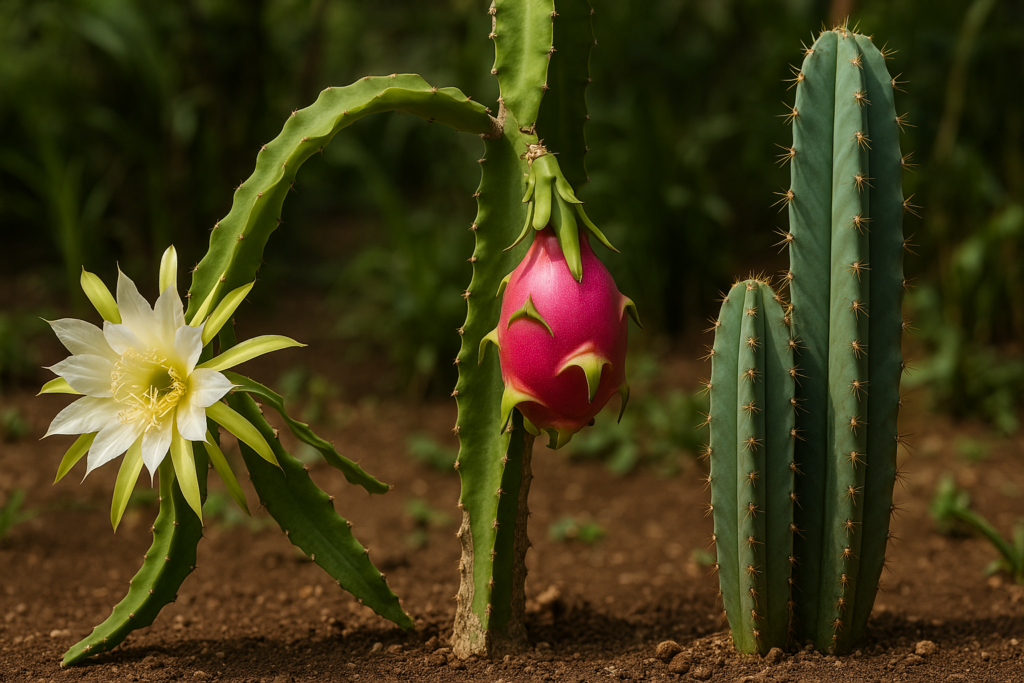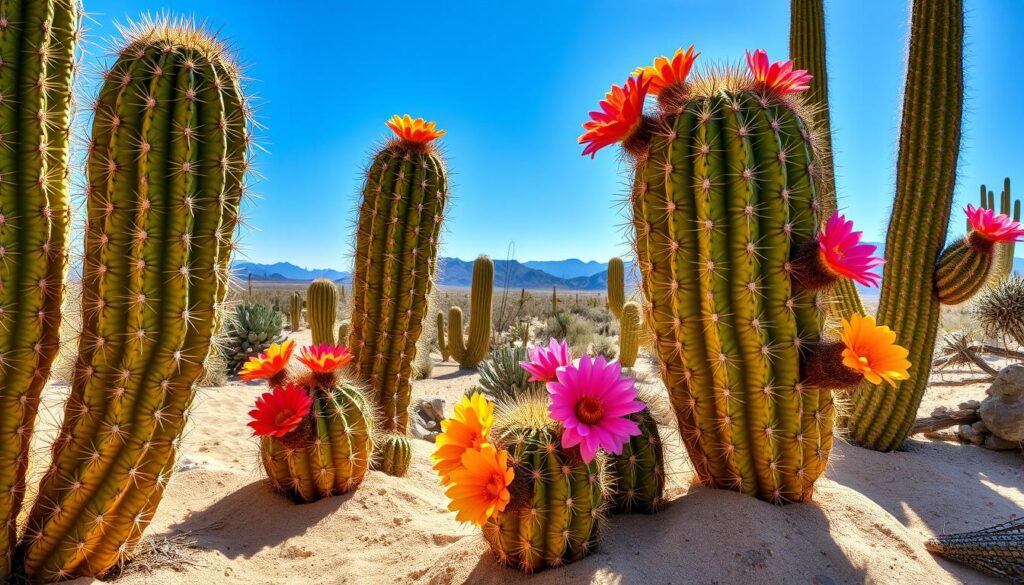Fast-Growing Cacti: Wild Beauty and Rapid Growth in Your Garden
Discover how Selenicereus grandiflorus, Hylocereus undatus, and Echinopsis pachanoi can transform your green space in record time

Imagine having a garden that grows almost before your eyes — lush, exotic, and practically self-sufficient. While many people associate cacti with slowness and stillness, some species surprise even the most experienced gardeners with their accelerated development and sculptural forms.
Among the hundreds of known species, three stand out for their fast growth and unique aesthetics: Selenicereus grandiflorus, Hylocereus undatus, and Echinopsis pachanoi. These cacti not only break the slow-growth stereotype but also offer striking visual and sensory experiences.
If you are looking for a hardy plant that is easy to care for and delivers quick results — whether to decorate your home, balcony, or garden — this article is for you. Get ready to learn how to grow, speed up development, and make the most of these three botanical wonders.
By the end of this read, you’ll be able to choose the ideal cactus for your lifestyle and available space, and even learn how to boost its growth using simple, effective techniques. Shall we?
Why Choose Fast-Growing Cacti?
It may sound contradictory, but many cactus lovers feel frustrated with how slow their plants grow. After all, who hasn’t bought a small pot hoping to see it become a stunning decorative piece — only to find it looking the same years later?
That’s why fast-growing cacti are gaining popularity among urban gardeners, collectors, and landscapers. They offer the best of both worlds: they are hardy, low-maintenance plants that reward you with noticeable growth in just a few months.
Additionally, these species are versatile. They can thrive in pots, vertical gardens, or directly in the ground — adapting well to both small and large spaces. Plus, they produce flowers, fruits, and structures that add texture and movement to your decor.
And there’s a symbolic factor, too. Fast-growing cacti represent renewal, progress, and adaptability — concepts that resonate especially with city dwellers looking to bring a touch of nature into their fast-paced lives.
Selenicereus grandiflorus: The Queen of the Night in Fast Motion
Few plants are as mystical and stunning as Selenicereus grandiflorus. Popularly known as the “Queen of the Night,” this species is famous for producing spectacular flowers that bloom at night and release a captivating fragrance.
But what many do not know is that, under the right conditions, it grows surprisingly fast. Its long, trailing stems can reach several meters in just a few months, especially when planted in well-lit, mild environments.
Beyond its exotic beauty, the Queen of the Night is perfect for hanging pots, trellises, or walls where it can spread freely. The visual effect is breathtaking — not just at night when it blooms, but year-round with its thick, green stems.
To grow it successfully, use a light, well-drained substrate, water moderately, and fertilize monthly during spring and summer. Pruning also helps, guiding growth and encouraging new branches.
Hylocereus undatus: Tropical Beauty and Delicious Fruit
If you’ve ever heard of dragon fruit (pitaya), then you already know Hylocereus undatus. This species is not only visually striking — with its bright green stems and sculptural structure — but also one of the fastest-growing cacti out there.
Hylocereus starts growing noticeably just weeks after planting. When supported by a trellis or stake, it develops vigorously, forming green columns that can produce fruit in less than two years.
It thrives with plenty of sunlight, fertile and well-drained soil, and regular watering (without overdoing it). This species loves warmth and moderate humidity, making it ideal for tropical and subtropical climates.
Best of all? Hylocereus undatus offers more than beauty — it’s a functional food source, with antioxidant-rich pulp full of vitamins and fiber. Perfect for those who want to combine décor, home gardening, and healthy eating.
Interested in growing your own dragon fruit plant? A great option is to buy certified seedlings from a reliable source. On Rarexoticseeds, you’ll find selected Hylocereus undatus seeds ready to sprout.
Echinopsis pachanoi: The San Pedro Cactus and Its Ancient Power
Also known as San Pedro, Echinopsis pachanoi has a rich, ancient history. Native to the Andes, this columnar cactus has been cultivated for centuries by indigenous communities — not just for its fast growth and beauty, but for its spiritual and cultural value.
When it comes to growth, it’s truly a marvel. In ideal conditions, San Pedro can grow up to 30 centimeters (12 inches) per year, quickly reaching impressive heights. Its thick, blue-green stem features soft ribs and gentle spines, making it a safer option for gardens with kids and pets.
Growing it is easy: use well-drained soil, provide a few hours of sunlight each day, and water moderately. It thrives in dry climates and tolerates mild temperatures, making it great for highland regions or rock gardens.
In landscaping, San Pedro stands out with its upright, sculptural presence. Use it as a focal point in desert gardens, large pots in entryways, or even in minimalist compositions. It’s a cactus that radiates strength, peace, and spiritual energy.
Important: Since Echinopsis pachanoi contains psychoactive alkaloids, it should be cultivated responsibly — strictly for ornamental, educational, or botanical preservation purposes. Its ritual and medicinal uses belong to specific cultural traditions and must be respected.
How to Boost Your Cactus’s Growth Even More
Now that you’ve discovered the right species, you may be wondering: how can I speed up their growth even more? The good news is that a few simple habits can help — no chemicals or advanced techniques required.
1. Proper Lighting
Most cacti love the sun, but too much can hinder growth, especially in tropical species like Hylocereus. Ideally, give them 4 to 6 hours of direct sunlight per day, with partial shade during peak heat hours.
2. Light, Well-Drained Soil
Fast-growing cacti prefer airy soil. A mix of potting soil, coarse sand, and perlite works perfectly. Avoid compact soils or overly rich composts, which can retain moisture and cause root rot.
3. Smart Watering
During spring and summer, water whenever the top half of the soil feels dry. In fall and winter, reduce watering to match the plant’s slower metabolism. Cacti that get the right amount of water grow faster and healthier.
4. Thoughtful Fertilizing
Use fertilizers rich in phosphorus and potassium to promote roots and stem growth. Apply diluted liquid fertilizer every 20 days during the growing season. Avoid nitrogen-heavy formulas, which create soft, weak growth.
5. Pruning and Guiding Growth
Yes, pruning cacti is possible! Strategic cuts can encourage branching and new shoots, especially in Selenicereus and Hylocereus. Always use gloves and sterilized tools to prevent infection.
Are Fast-Growing Cacti Good for Small or Vertical Spaces?
If you live in an apartment or have a small balcony, you might be asking, “Are these cacti for me?” The answer is yes — and stylishly so!
- Selenicereus grandiflorus is perfect for hanging pots and vertical gardens. Its trailing stems create a stunning waterfall effect.
- Hylocereus undatus, when supported by stakes or trellises, becomes a productive and decorative living wall.
- Echinopsis pachanoi, in tall pots, turns into a green totem — an eye-catching focal point, even in tight spaces.
Besides their looks, these cacti also help regulate indoor humidity, improve air quality, and bring a calming natural vibe — all in areas that are often underused.
Pair them with natural elements like stones, clay pots, accent lighting, or even minimalist sculptures. The contrast between the vibrant green and earthy textures creates a modern, personalized aesthetic.
Conclusion – The Power of Visible Growth
Planting a cactus and watching it grow quickly is more than a hobby — it’s an experience. It connects you with nature’s rhythm, renewal cycles, and the wild beauty that thrives even in urban settings.
The species we explored — Selenicereus grandiflorus, Hylocereus undatus, and Echinopsis pachanoi — are not just beautiful and resilient. They defy expectations, offering flowers, fruits, and incredible forms — all with very little maintenance.
If you’re looking for a plant that demands little but gives a lot — in form, color, and presence — fast-growing cacti are the perfect choice.
Recommended Content: Vertical Garden Ideas

